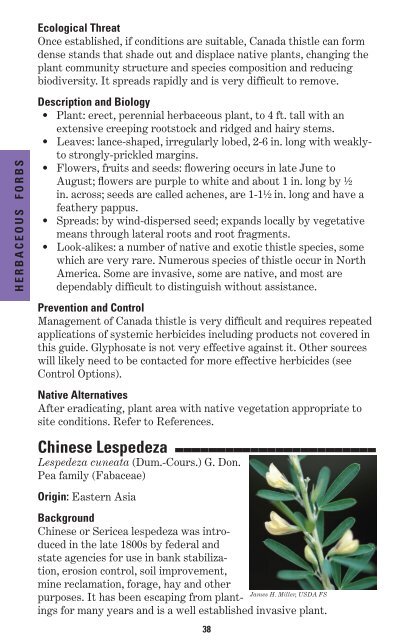Plant Invaders of Mid-Atlantic Natural Areas - National Park Service
Plant Invaders of Mid-Atlantic Natural Areas - National Park Service
Plant Invaders of Mid-Atlantic Natural Areas - National Park Service
Create successful ePaper yourself
Turn your PDF publications into a flip-book with our unique Google optimized e-Paper software.
HERBACEOUS FORBS<br />
Ecological Threat<br />
Once established, if conditions are suitable, Canada thistle can form<br />
dense stands that shade out and displace native plants, changing the<br />
plant community structure and species composition and reducing<br />
biodiversity. It spreads rapidly and is very difficult to remove.<br />
Description and Biology<br />
• <strong>Plant</strong>: erect, perennial herbaceous plant, to 4 ft. tall with an<br />
extensive creeping rootstock and ridged and hairy stems.<br />
• Leaves: lance-shaped, irregularly lobed, 2-6 in. long with weaklyto<br />
strongly-prickled margins.<br />
• Flowers, fruits and seeds: flowering occurs in late June to<br />
August; flowers are purple to white and about 1 in. long by ½<br />
in. across; seeds are called achenes, are 1-1½ in. long and have a<br />
feathery pappus.<br />
• Spreads: by wind-dispersed seed; expands locally by vegetative<br />
means through lateral roots and root fragments.<br />
• Look-alikes: a number <strong>of</strong> native and exotic thistle species, some<br />
which are very rare. Numerous species <strong>of</strong> thistle occur in North<br />
America. Some are invasive, some are native, and most are<br />
dependably difficult to distinguish without assistance.<br />
Prevention and Control<br />
Management <strong>of</strong> Canada thistle is very difficult and requires repeated<br />
applications <strong>of</strong> systemic herbicides including products not covered in<br />
this guide. Glyphosate is not very effective against it. Other sources<br />
will likely need to be contacted for more effective herbicides (see<br />
Control Options).<br />
Native Alternatives<br />
After eradicating, plant area with native vegetation appropriate to<br />
site conditions. Refer to References.<br />
Chinese Lespedeza ________________________<br />
Lespedeza cuneata (Dum.-Cours.) G. Don.<br />
Pea family (Fabaceae)<br />
Origin: Eastern Asia<br />
Background<br />
Chinese or Sericea lespedeza was introduced<br />
in the late 1800s by federal and<br />
state agencies for use in bank stabilization,<br />
erosion control, soil improvement,<br />
mine reclamation, forage, hay and other<br />
James H. Miller, USDA FS<br />
purposes. It has been escaping from plantings<br />
for many years and is a well established invasive plant.<br />
38

















